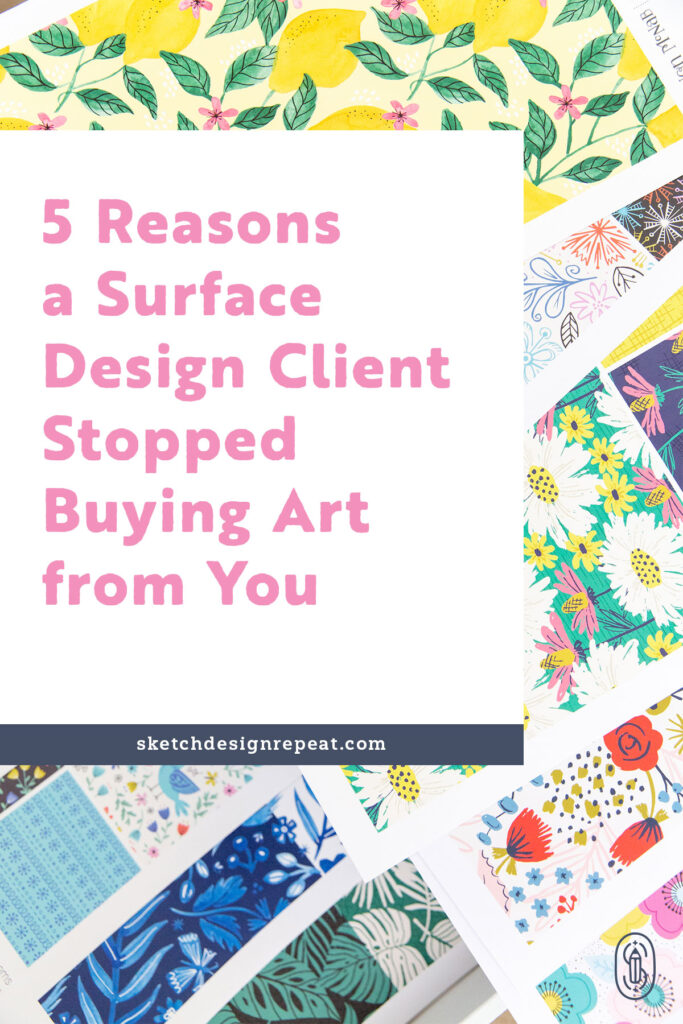The experience I gained as a former art buyer has helped me tremendously in pursuing my own career in surface pattern design and illustration, particularly as it relates to the designer relationships I was responsible for managing.
I’ve already discussed my best tips for creating a good pitch email and my thoughts on why you might not have heard back from an Art Director. But what if you’ve been licensing or selling your artwork to your clients but haven’t been able to get repeat business from them?

It may feel like you’re being ghosted, something that’s not only specific to our industry but all social interactions.
If you suspect this may be the case, ask yourself when thinking about your existing client list: is there a thread of consistency in my interactions with my clients that could explain why I’m not receiving repeat business?
There are so many complexities in all client relationships and some reasons behind not working with a client again may be out of your control and haven’t been communicated to you. Here are five reasons you might not be receiving repeat business for your art:
1. Budget
There were a couple of times a year with the company I was working for only needed a small amount of themed artwork. My process was to first approach my “go-to” list of artists that I had an existing relationship with because I knew I could count on them.
As time went on and we needed another batch, I would ask another set of artists that I had started working with to diversify the art. It was only for the top-selling categories that I would open up my list of artists and ask everyone for art.
Consider the state of the economy as well. This affects company budgets and may change from year to year. A company art budget is out of our control as artists, but it can help with following up periodically to see if a company has any specific art needs and to keep yourself at the top of an Art Director’s mind.
2. You’re not flexible in making changes
I understand where artists are coming from as a working freelance graphic designer and illustrator myself in not wanting to make large amounts of changes. I have a clause in my freelance work agreement that specifically addresses this to limit endless amounts of revisions.
It can be really frustrating. However, having been on the other end, making requests for adjustments, I have a greater understanding of the times when it is needed.
Any requested changes were always for our mutual benefit. Having worked for my former employer for almost a decade, I had a good understanding of our customers and target audience. I also regularly looked at the sales of the designs that sold the best.
Remember, your art is there to serve a need and any requests made within reason are to help in selling the products. What’s within reason, you ask? I think it’s up to each person to figure out their limits but for myself, I think color adjustments, minor changes to the placement of art elements to work for production or make the design stronger, and switching out fonts are standard requests.
3. You don’t communicate well or are difficult to work with
One time I asked an artist if they could make an adjustment to their artwork and they had their art rep respond back saying they didn’t want to make the change.
While I think it’s fine to say you don’t want to make a change, it put a bad taste in my mouth when they couldn’t communicate that directly with me. We even acquired the art as is after this. But from that moment on, this interaction made me think of them as difficult to work with and it was always in the back of my head when I considered reaching out to them moving forward.
Part of communicating well is being able to convey things that may be uncomfortable. What you impart isn’t necessarily a deal breaker, but how it’s relayed is important.
I also thought of artists as difficult to work with if they complained about adjustments being requested or submissions that were turned down. It’s understandable to be disappointed when it’s not all smooth sailing in getting art accepted right off the bat, but it’s important to take any feedback with grace, even if you don’t agree with it.

4. You don’t regularly market your brand/art to them
Part of my job as an art buyer was to manage designer relationships. At the time I left, we had agreements with more than 90 artists. I remembered all of them but also had a small list of designers I reached out to regularly.
There were a handful of artists that wouldn’t have made that list except they consistently reached out to me either through direct emails asking if there were particular needs we had at the time or through their monthly art newsletters. Most of the time there wasn’t anything needed at the time but I was able to give them a heads up to the next theme we were looking for and around the time I would be reaching out for it.
They might not have been on my list, but I would make a point to add them when the time came because they reached out to me and asked. Sometimes the Art Director at our company would also see the monthly art newsletters and would think something shown would work well for a particular product or theme.
5. Your files are a mess
It was always a pain when an artist’s files were unorganized. Layers wouldn’t be named, the guide file from another company was used instead of the ones provided to them, fonts weren’t outlined or rasterized that should have been, or all the layers were flattened, making it impossible to implement the design in our software.
It was especially frustrating because we always provided a document when they signed their contract that listed out all the preferences for setting up files. So when they didn’t follow the guidelines, it meant more work to do prepping their files so everything would flow smoothly for the production phase. The less work there was to do, the faster and more likely their art would be made available first.

Even if you’re guilty of one of the five reasons mentioned above, there are some things you can do to alleviate these issues and continue on your path to better client relationships.
Best practices for maintaining an established working relationship with a client
- Think about the policies you want to establish for yourself in making changes. What is reasonable for you? If a client asks for something past your boundaries, then communicate that it’s outside of your policy to do so. That’s a fair response and displays professionalism.
- It’s okay to have disagreements but make sure to communicate them respectfully and don’t use a middleman to communicate them for you whenever possible.
- Keep yourself in the forefront of their minds by sending out an art newsletter consistently. I loved getting art newsletters and looked forward to receiving them. Or if you have some downtime, reach out and see if they have any particular needs.
- Follow any guidelines from documents you may have received when setting up your files. And if you have any questions, ask. The easier you make it for your client the more likely you will be seen in a positive light.
Lastly, do you want to keep working with a client?
It’s completely reasonable to reconsider your relationship if a client is difficult to work with and is a bad communicator. Think about how many clients you need and want to sustain your business. Find your gem client.
Persistence may be the key to success, but I think being a good communicator and taking into consideration your client’s needs is essential in maintaining a consistent relationship with them.

Written by Cody Alice Moore
Website: www.codyalicemoore.com
Instagram: @codyalicemoore
Class: Client Feedback Strategies for Creatives
Cody is an artist, illustrator, and surface pattern designer with over 15 years of experience. Cody discovered surface design while working for four years as an art buyer for a national photo lab. Since 2019, she has been creating art full-time for her budding portfolio and growing collection of licensed designs.
Thank you for a very informative article!
Amazing amazing Information!!! thanks a lot for sharing.
Thanks for sharing this insightful information!